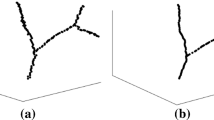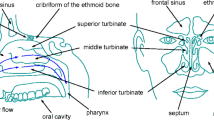Abstract
A method is proposed to improve the quality of the three-dimensional airway geometric models using a commercial software, checking the number of elements, meshing time, and aspect ratio and skewness parameters. The use of real and virtual topologies combined with patch-conforming and patch-independent meshing algorithms results in four different models being the best solution the combination of virtual topology and patch-independent algorithm, due to an excellent aspect ratio and skewness of the elements, and minimum meshing time. The result is a reduction in the computational time required for both meshing and simulation due to a smaller number of cells. The use of virtual topologies combined with patch-independent meshing algorithms could be extended in bioengineering because the geometries handling is similar to this case. The method is applied to a healthy person using their computed tomography images. The resulting numerical models are able to simulate correctly a forced spirometry.

















Similar content being viewed by others

References
3D Slicer V4.4.0 (2014). https://www.slicer.org
Agujetas R, Ferrera C, Marcos AC, Alejo JP, Montanero JM (2017) Numerical and experimental analysis of the transitional flow across a real stenosis. Biomech Model Mechanobiol 16(4):1447–1458. https://doi.org/10.1007/s10237-017-0898-2
Ansys version 16.2 (2015) ANSYS Inc
Ashurst I, Malton A, Prime D, Sumby B (2000) Latest advances in the development of dry powder inhalers. Pharm Sci Technol Today 3:246–256
Choi L (2007) Simulation of fluid dynamics and particle transport in realistic human airways. Master’s thesis, School of Aerospace, Mechanical and Manufacturing Engineering, RMIT University, Melbourne, Australia
De Backer JW, Vos WG, Devolder A, Verhulst SL, Germonpré P, Wuyts FL, Parizel PM, De Backer W (2008) Computational fluid dynamics can detect changes in airway resistance in asthmatics after acute bronchodilation. J Biomech 41:106–113
De Backer JW, Vos WG, Vinchurkar SC, Claes R, Drollmann A, Wulfrank D, Parizel PM, Germonpré P, De Backer W (2010) Validation of computational fluid dynamics in CT-based airway models with SPECT/CT. Radiology 257:854–862
De Backer LA, Vos W, De Backer J, Van Holsbeke C, Vinchurkar S, De Backer W (2012) The acute effect of budesonide/formoterol in COPD: a multi-slice computed tomography and lung function study. Eur Respir J 40:298–305
Dyedov V, Einstein DR, Jiao X, Kuprat AP, Carson JP, Pin F (2009) Variational generation of prismatic boundary-layer meshes for biomedical computing. Int J Numer Meth Eng 79:907–945
Fedorov A et al (2012) 3D slicer as an image computing platform for the quantitative imaging network. Magn Reson Imag 30:1323–1341
Fernández-Tena A (2014) Clinical applications of fluid dynamics models in respiratory disease. Ph.D. thesis, University of Oviedo, Spain. http://digibuo.uniovi.es/dspace/handle/10651/29057
Fernández-Tena A, Casan Clarà P (2015) Use of computational fluid dynamics in respiratory medicine. Arch Bronconeumol 2015(51):293–298
Fernández-Tena A, Fernández J, Casan P (2016) Particle deposition in healthy and bronchoconstricted lung. Eur Respir J 48(60):PA4402
Fernández-Tena A, Fernández J, Álvarez E, Casan P, Walters K (2017a) Design of a numerical model of lung by means of a special boundary condition in the truncated branches. Int J Numer Methods Biomed Eng 33(6):e2830
Fernández-Tena A, Marcos AC, Martínez C, Walters DK (2017b) A new adaptive time step method for unsteady flow simulations in a human lung. Comput Methods Biomech Biomed Eng 20(8):915–917
Foucault G, Cuilliére JC, Francoise V, Leon JC, Maranzana R (2007) Adaptation of cad model topology for finite element analysis. Comput Aided Des 40:176–196
Gibson GJ, Loddenkemper R, Sibille Y, Lundbäck B, Fletcher M (2013) Lung health in europe: facts and figures. European Lung Foundation, Sheffeld
Hofmann W, Martonen TB, Graham RC (1989) Predicted deposition of nonhygroscopic aerosols in the human lung as a function of subject age. J Aerosol Med 1989(2):49–68
Hörschler I, Meinke M, Schröder W (2003) Numerical simulation of the flow field in a model of the nasal cavity. Comput Fluids 32:39–45
Hounsfield GN (1973) Computerized transverse axial scanning (tomography): part I. Description of system. Br J Radiol 46:1016–1022
Inthavong K, Choi L, Tu J, Ding S, Thien F (2010) Micron particle deposition in a tracheobronchial airway model under different breathing conditions. Med Eng Phys 32:1198–1212
Islam MS, Saha SC, Sauret E, Gu Y, Ristovski Z (2015) Numerical investigation of aerosol particle transport and deposition in realistic lung airway. In: Liu GR, Das R (eds) The 6th international conference on computational methods (ICCM2015), ICCM. Scientech Publisher llc, USA, Auckland, New Zealand
Jahangiri M, Saghafian M, Sadeghi MR (2015) Numerical study of turbulent pulsatile blood flow through stenosed artery using fluid–solid interaction. Comput Math Methods Med 2015:515613
Kannan R, Guo P, Przekwas A (2016) Particle transport in the human respiratory tract: formulation of a nodal inverse distance weighted Eulerian–Lagrangian transport and implementation of the Wind–Kessel algorithm for an oral delivery. Int J Numer Meth Biomed Eng 32(6). https://doi.org/10.1002/cnm.2746
Kannan R, Singh N, Przekwas A, Delvadia R, Tian G, Walenga R (2017a) Pharmaceutical aerosols deposition patterns from a dry powder inhaler: Euler Lagrangian prediction and validation. Med Eng Phys 42:35–47
Kannan R, Chen ZJ, Singh N, Przekwas A, Delvadia R, Tian G, Walenga R (2017b) A quasi-3D wire approach to model pulmonary airflow in human airways. Int J Numer Methods Biomed Eng 33(7):e2838
Kitaoka H, Takaki R, Suki B (1999) A three-dimensional model of the human airway tree. J Appl Physiol 87(6):2207–2217
Kleinstreuer C (2006) Biofluid dynamics: principles and selected applications. CRC Press, Boca Raton
Kleinstreuer C, Zhang Z, Donohue JF (2008) Targeted drug-aerosol delivery in the human respiratory system. Annu Rev Biomed Eng 10:195–220
Kolanjiyil AV, Kleinstreuer C, Sadikot RT (2017) Computationally efficient analysis of particle transport and deposition in a human whole-lung-airway model. Part II: dry powder inhaler application. Comput Biol Med 84:247–253
Lin C, Tawhai MH, Merryn H, McLennan G, Hoffman EA (2007) Characteristics of the turbulent laryngeal jet and its effect on airflow in the human intra-thoracic airways. Respir Physiol Neurobiol 157:295–309
Lip K, Philip C (2015) Pharmaceutical aerosol electrostatics: a field with much potential for development. Ther Deliv 6:105–107
Marchandise E, Geuzaine C, Remacle JF (2013) Cardiovascular and lung mesh generation based on centerlines. Int J Numer Method Biomed Eng 2013(29):665–682
Menter F, Langtry R, Völker S (2006) Transition modelling for general purpose CFD codes. Flow Turbul Combust 77:277–303
Miller MR, Hankinson JATS, Brusasco V, Burgos F, Casaburi R, Coates A, Crapo R, Enright P, Van der Grinten CP, Gustafsson P et al (2005) Standardisation of spirometry. Eur respir J 26(2):319–338
Miyawaki S, Tawhai MH, Hoffman EA, Wenzel SE, Lin CL (2017) Automatic construction of subject-specific human airway geometry including trifurcations based on a CT-segmented airway skeleton and surface. Biomech Model Mechanobiol 16:583–596
Nahar K, Gupta N, Gauvin R, Absar S, Patel B, Gupta V, Khademhosseini A, Ahsan F (2013) In vitro, in vivo and ex vivo models for studying particle deposition and drug absorption of inhaled pharmaceuticals. Eur J Phar Sci 49:805–818
OECD/UE (2016) Health at a glance: Europe 2016. state of health in the EU cycle. Technical report OECD/UE
Przywara B (2010) Projecting future health care expenditure at European level: drivers, methodology and main result. European Commission, Economic and Financial Affairs Publications, Brussels
Rochefort L, Vial L, Fodil R, Mâıtre X, Louis B, Isabey D, Caillibotte G, Thiriet M, Bittoun J, Durand E, Sbirlea-Apiou G (2007) In vitro validation of computational fluid dynamic simulation in human proximal airways with hyperpolarized 3 He magnetic resonance phase-contrast velocimetry. J Appl Physiol 102:2012–2023
Sbirlea-Apiou G, Katz I, Caillibotte G, Martonen T, Yang Y (2007) Deposition mechanics of pharmaceutical particles in human airways. In: Hickey AJ (ed) Inhalation aerosols. Physical and biological basis for therapy, 2nd edn. Informa Healthcare USA, New York, pp 1–30
Scotti A, Piomelli U (2002) Turbulence models in pulsating flows. AIAA 40:537–544
Stahlhofen W, Rudolf G, James AC (1989) Intercomparison of experimental regional aerosol deposition data. J Aerosol Med 1989(2):285–308
Streinbenner JP, Wyman NJ, Chawner JR (2000) Fast surface meshing on imperfect cad models. In: 9th international meshing roundtable, Sandia National Laboratories, New Orleans, USA, pp 33–41
Taherian S, Rahai HR, Waddington T (2011) CFD modelling and analysis of pulmonary airways/particles transport and deposition. In: 41st AIAA fluid dynamics conference and exhibit, American Institute of Aeronautics and Astronautics. American Institute of Aeronautics and Astronautics, Honolulu, USA, pp 2011–3270
Tan FPP, Wood NB, Tabor G, Xu XY (2011) Comparison of LES of steady transitional flow in an idealized stenosed axisymmetric artery model with a RANS transitional model. J Biomech Eng 133:051001
Varghese SS, Frankel SH, Fischer PF (2007a) Direct numerical simulation of stenotic flows. Part 1. Steady flow. J Fluid Mech 582:253
Varghese SS, Frankel SH, Fischer PF (2007b) Direct numerical simulation of stenotic flows. Part 2. Pulsatile flow. J Fluid Mech 582:281
Varghese SS, Frankel SH, Fischer PF (2008) Modelling transition to turbulence in eccentric stenotic flows. J Biomech Eng 130:014503
Versteeg HK, Malalasekera W (2007) An Introduction to Computational Fluid Dynamics. Pearson Education Limited, England
Vos W, De Backer J, Poli G, De Volder A, Ghys L, Van Holsbeke C, Vinchurkar S, De Backer L, De Backer W (2013) Novel functional imaging of changes in small airways of patients treated with extrafine beclomethasone/formoterol. Respiration 86:393–401
Weibel ER (1963) Morphometry of the human lung. Academic, New York
Weibel ER (2009) What makes a good lung? The morphometric basis of lung function. Swiss Med Wkly 139:375–386
Wilcox DC (2006) Turbulence modelling for CFD. DCW Industries, Flintridge
Zhang Y, Finlay WH (2005) Measurement of the effect of cartilaginous rings on particle deposition in a proximal lung bifurcation model. Aerosol Sci Technol 39:394–399
Zhang Z, Kleinstreuer C, Hyun S (2012) Size-change and deposition of conventional and composite cigarette smoke particles during inhalation in a subject-specific airway model. J Aerosol Sci 45:34–52
Zheng J (2014) Numerical simulation of nanoparticle transportation and deposition in pulmonary vasculature. Master’s thesis, Department of Mechanical Engineering and Mechanics, Lehigh University, Lehigh, USA
Acknowledgements
Thanks to Dr. Alejo, Servicio Radiología (Hospital IC, Badajoz), who provided the images of this study. This work was financially supported by Junta de Extremadura under Project “Ayudas para la realización de actividades de investigación y desarrollo tecnológico, de divulgación y de transferencia de conocimiento por los Grupos de Investigación de Extremadura (GR150014)” and Sociedad Asturiana de Patología Respiratoria under project Experimental and numerical study of a three-dimensional model of an asthmatic patient airways reconstructed from CT or MR images.
Author information
Authors and Affiliations
Corresponding author
Ethics declarations
Conflict of interest
The authors declare that they have no conflict of interest.
Rights and permissions
About this article
Cite this article
Fernández-Tena, A., Marcos, A.C., Agujetas, R. et al. Simulation of the human airways using virtual topology tools and meshing optimization. Biomech Model Mechanobiol 17, 465–477 (2018). https://doi.org/10.1007/s10237-017-0972-9
Received:
Accepted:
Published:
Issue Date:
DOI: https://doi.org/10.1007/s10237-017-0972-9



